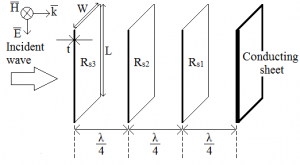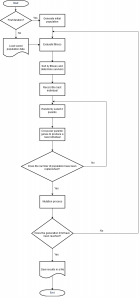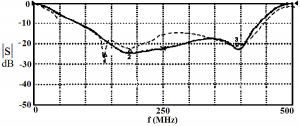Brief History and Description of Jaumann Wave Absorber
Detection of solid objects using radio waves was first demonstrated as early as 19th century, but it wasn’t until WW2 that radar became widely used in full scale war. During the war, both the US and Germany entered an arms race in developing electromagnetic wave absorbing materials to counter each others’ radar technology. Eventually, a German engineer named J. Jaumann developed wave absorber design which was considered the most effective among other designs and according to a declassified WW2 document, it was installed in at least 60 German submarines at that time.
The absorber consists of multiple resistive layers placed a quarter wavelength apart with a conducting sheet at the end (Figure 1). By varying the values of the resistive layers, we can control the bandwidth and absorption level. Furthermore, adding more layers widens the bandwidth at the cost of increasing the size of absorber.

Genetic Algorithm
One key feature of Jaumann wave absorber is versatility. There exists an infinite amount of solutions to the absorber system. While the absorbers were initially designed through trial-and-error method, we can develop algorithms to search for a specific solution to achieve the desired absorption level, bandwidth, center frequency, and thickness of the absorber system. In this work, we developed Genetic Algorithm to accomplish the goal.

Figure 2 shows our genetic algorithm flowchart. We design the algorithm to independently vary the spacings between the resistive layers instead of fixed quarter wavelength distance. In addition, we define the spacing and resistive values in such a way so that they both are within the same scale and can be mutated and computed at the same time (though the crossover process is still limited within each group). This method saves computation time and simplifies our algorithm. In conclusion, our algorithm offers flexibility of:
1. Setting any minimum absorption level and ensures the absorption spectrum does not fluctuate across that minimum level.
2. Non-trivially reducing the design size (68%, 20%, and 33% shorter than ref [3, 4, 5] respectively) while maintaining same or better absorption performance.
3. Varying the spacings between layers independently in contrast of ref [5], which results in bigger search space.
Simulation and Experiment
We design the circuit board equivalent (shown in Figure 3) of Jaumann wave absober and we perform simulation at the circuit level. Then we compare the resulting S11 parameter with experiment as shown in Figure 4. Imperfections in the result are mainly due to stray inductances of the lumped elements and connectors used.


For more information:
[1]. Maximally-Flat and Genetic Algorithm Solutions to Achieve Wideband Jaumann Absorbers
[2]. Declassified WW2 document: The Schornsteinfeger Project
[3]. A. R. Foroozesh, A. Cheldavi, and F. Hodjat, Design of jaumann absorbers using adaptive genetic algorithm,” in Antennas, Propagation and EM Theory, 2000. Proceedings. ISAPE 2000. 5th International Symposium on. IEEE, 2000, pp. 227-230.
[4]. B. Chambers and A. Tennant, Optimised design of jaumann radar absorbing materials using a genetic algorithm,” IEE Proceedings-Radar, Sonar and Navigation, vol. 143, no. 1, pp. 23-30, 1996.
[5]. P. Saville, Genetic algorithm optimization of multilayer jaumann absorbers. oblique in- cidence,” DEFENCE RESEARCH AND DEVELOPMENT ATLANTIC DARTMOUTH (CANADA), Tech. Rep., 2005.